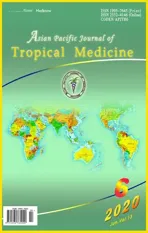Structural biology oriented predicative analysis of immunogenic epitopes on SARS-CoV-2 viral sequence by variable algorithms
2020-06-18DhanasekaranSivaraman
Dhanasekaran Sivaraman
1Department of Pharmacology and Toxicology, Centre for Laboratory Animal Technology and Research, Sathyabama Institute of Science and Technology, Jeppiaar Nagar, Chennai 600119, Tamil Nadu, India
2School of Pharmacy, Sathyabama Institute of Science and Technology, Jeppiaar Nagar, Chennai 600119, Tamil Nadu, India
3Chinese Association for Laboratory Animal Sciences, Chaoyang District, Beijing 100021, China
Epitopes are small segmented antigenic peptides that are able to elicit the immune response by recognizing B and T-cells. In the present scenario, knowledge of immunogenic epitopes specific to severe acute respiratory syndrome coronavirus (SARS-CoV-2)becomes highly essential for understanding the disease pathogenesis,etiology, disease screening and also for the development of suitable viral vaccine candidates.
The immune system of SARS-CoV-2 affected individuals pursue spectacular dynamism in processing the viral antigen. It was evident that the initial phase of infection was generally managed by the adaptive immune mechanisms, hence well balanced human leukocyte antigen populations are highly successful in developing anti-viral immunity. On the other hand, failure of adaptive immune response triggers in flammatory and destructive changes in the vital organs (kidney, intestine and lungs)[1]. Oxidative stress increases the production of in flammatory mediators such as TNFα, IL & IFNγ that set up the condition of cytokine storms and further lead to acute respiratory distress[2,3].
Experts in the field of immunology claim that T-cells respond well to the immunogenic peptides via activated macrophages and B-cells respond by producing specific antibodies, which has potential to neutralize the viral antigen. In this context, vaccination may be expected to boost immunity in the earlier adaptive phase[4].
Earlier publication of the world’s first report on epitope identification grabs the attention of researchers in the field of immunology, and provides insight into their prediction authors have utilized a single algorithm module for distinguishing B-cell specific epitope[5]. Whereas in the event of triggering host immune response,T-cell plays an inevitable role and gains paramount importance in addition to B-cell. Hence, the present investigation aimed at identifying multiple immunogenic epitopes specific for both B and T-cells. This attempt would substantially benefit researchers in understating the residual biology of the antigenic epitopes that serves as a viable target for potential vaccine against novel coronavirus.
Sequences of SARS-CoV-2 that causes COVID-19 were retrieved from the National Center for Biotechnology Information (Ref Seq:NC_045512.2). The corresponding protein structure was generated using a docking server platform simulated by Autodock 4. Epitope identification screening was performed by Phyre version 2, Ez Mol viewer and also by immune epitope database analysis/BepiPred-2.0. Three dimensional structures of SARS-CoV-2 viral amino acid highlighting the potential antigenic epitopes specific for T and B-cells are illustrated in Figure 1.
Five potential antigenic peptide sequences specific for B-cells were identified using variable algorithm based immune prediction analysis. The first peptide sequence (EDEEEGD) located at position 122 was suggested by Parker hydrophilicity prediction; the second sequence RKQDDK at position 323 by Emini surface accessibility;the third immunogenic sequence (KHCLHVV) at position 235 by using Kolaskar and Tongaonkar Antigenicity prediction; the fourth sequence (GSNQNGE) at position 959 by Karplus and Schulz Flexibility and the fifth sequence (PGDSSSG) at position 1431 by Chou and Fasman-Turn beta-turn predictions as shown in Table 1.

Figure 1. 3D structure of SARS-CoV-2 viral amino acid highlighting potential antigenic epitopes specific for T and B-cells.

Table 1. Summarising B-cell antigenic epitopes by variable algorithms.
Our results further summarize that nearly 26 different peptides with T-cell immunogenic potential (MHC-HLA-DRB1, 3, 4,5 specific) have been identified in the viral genome, of which the sequence 25 (SNFRVQPTESIQHRF) ranked first with the highest immunogenic score of 99.54, followed by the sequence 5 (AGIFGADPIHSLRVC), ranked second with 99.29 and the sequence 17 (AALALLLLDRLNQLE) ranked third with 98.03 in the scale of immunogenicity (supplementary Table 1).
The pandemic triggered by SARS-CoV-2 is already on the list of the greatest threats that human beings have ever encountered in modern history. Further emerging infection rates urge the need of potential vaccines that necessarily strengthen the immune system through humoral and adaptive backup.
In conclusion, the present analysis explores promising immunogenic epitopes of SARS-CoV-2 virus that could serve as an ideal target for potential vaccines.
Conflict of interest statement
The author declares no competing interests.
Acknowledgement
The author thanks the Indian Council of Medical Research (ICMR),Government of India, New Delhi.

Supplementary Figure 1. Trichosporon asahii was identified by the VITEK 2 compact automated system (left) and VITEK MS (right).

Supplementary Table 1. Summarising T-cell antigenic epitopes.
杂志排行
Asian Pacific Journal of Tropical Medicine的其它文章
- The 2019 novel coronavirus disease (COVID-19) pandemic: A zoonotic prospective
- The COVID-19 pandemic in the ASEAN: A preliminary report on the spread,burden and medical capacities
- Psychological impacts of the COVID-19 epidemic on Chinese people:Exposure, post-traumatic stress symptom, and emotion regulation
- Knowledge and attitude toward COVID-19 among healthcare workers at District 2 Hospital, Ho Chi Minh City
- Effect of ABCB1 3435C>T transporter gene polymorphism on plasma efavirenz concentration in HIV-1 infected Thai adults
- Analysis of temporal trends of human brucellosis between 2013 and 2018 in Yazd Province, Iran to predict future trends in incidence: A time-series study using ARIMA model
